I’m back in Lisbon. It’s been far too long – you know, with the pandemic and all. But now I’m back, and as I take a good look around, I realize how beautiful this city is and how much I’ve missed it: The steep cobblestone alleys, the past glory of the palaces alongside the boulevards, and the shabby charm of the houses in the backstreets. The majestic views from countless outlooks, and of course, the lovely ring of the rickety trams.
Come on, follow me down memory lane, and let’s rediscover the best of Lisbon!

Arriving in Lisbon
Being such a flatlander, I wasn’t really prepared for Portuguese cities to be so very hilly. That makes them beautiful and grants their visitors stunning views. However, for the arriving passenger, it’s quite a challenge.
Arriving at Lisbon’s Santa Apolónia station, I checked Google Maps for the way to my accommodation. I got the information, it was a bit over a kilometer, hence, no problem, totally walkable.
The app withheld the fun fact that it was a bit over a kilometer uphill. Partly on steep cobblestone alleys, partly on stairs. Less than a kilometer uphill on alleys and stairs quickly deems pretty far. Especially if you are dragging a suitcase on far too small wheels behind.

I was a heavily sweating mess as I arrived at the apartment and knocked at the neighbor’s door for the key.
Yes, correct, I stayed at an apartment. Nope, not the Airbnb kind. It was a small room on street level.
I technically lived on the street.
Welcome to My Crib
However, it was equipped with most things a visitor might need. Obviously, there was a bed – from IKEA, foldable. Also, a table and three chairs – not IKEA, but still foldable. A kitchenette, consisting of two hot plates, a microwave, a sink, and all the necessary utensils. There was even a washing machine, which was irritating since there was no closet. I wonder why they rather put a washing machine in such a small room than a closet. Especially since there was hardly space to hang your freshly washed laundry.
Maybe washing machines were on sale or so.
There was no TV. I didn’t need a TV, but there was no internet access, either.
Therefore, guests without a good old-fashioned book might get bored pretty fast.
Location Location Location
Enough with the weak points. The street-level apartment was in an incredible location: A narrow alley within the castle wall!
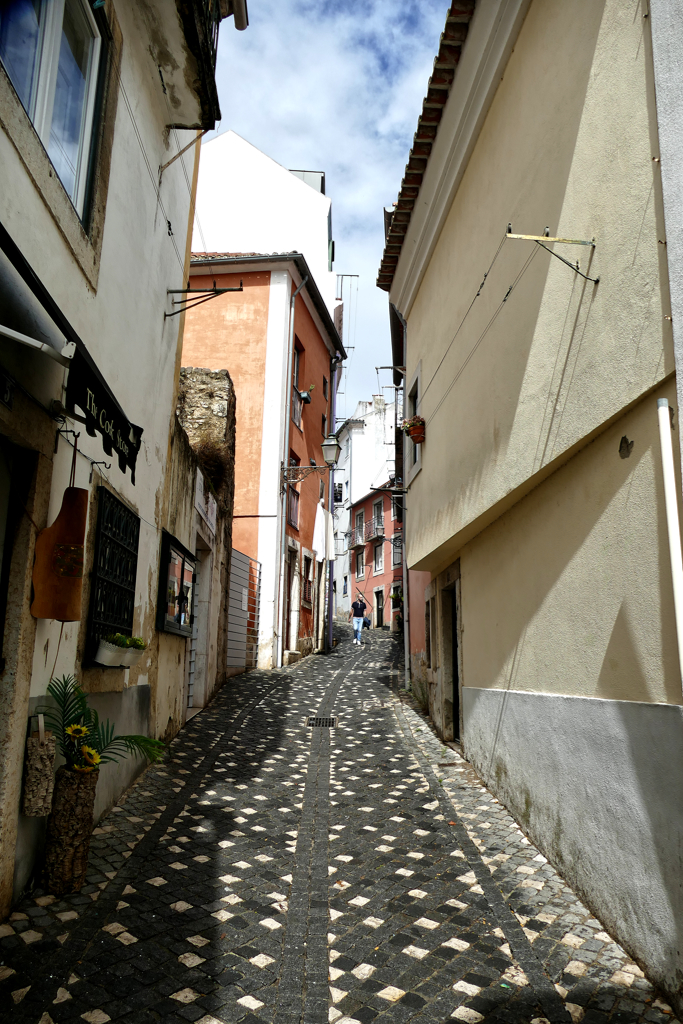
Tourists were passing right in front of my cobblestone alley-level door. There was neither an aircon nor a fan in the room. And since I left the door window open for fresh air, every single one of those tourists peeped into my room.
I didn’t blame them, that’s something you automatically do. They probably took me for a Portuguese bohemian.
I bet some of them were pretty jealous because of my million-dollar location.
I was staying right next to the castle, after all!
Within the castle walls!
Did I feel like a queen?
Nope, not on twenty square meters without a TV and without Wifi.
Rather like the queen’s washing woman living close by to be available at any time. I had a washing machine, after all.
Did I like staying at the posh, comfortable places in Porto and Figueira da Foz?
Yes.
Did I like staying at a rather run-down one-room apartment at the Castelo, doing my own grocery shopping, feeling like a true-born Portuguese?
Hell, yes!
Best of Lisbon
Lisbon is one of the oldest cities in Europe and offers the perfect mix of history, culture, and modern urban life. It is located on seven hills, giving it a spectacular geographical position and unparalleled views of the sea and the Tagus River. The city is often referred to as the City of Light due to the special, warm light.
The city has an eventful history that dates back to the time of the Phoenicians. In ancient times, it was an important trading center. Romans, Visigoths, and Moors took turns in dominance. Especially during the Moorish era, Lisbon developed into an important cultural and commercial center. You can still spot traces of this period in the architecture and urban structure, especially in the Alfama district. Yet, crusaders under the first king of Portugal, Afonso I, recaptured the city in 1147.
In the 15th and 16th centuries, during the Age of Discovery, Lisbon experienced its heyday.
Portugal became a leading naval power. The city served, among others, Vasco da Gama as a starting point for journeys of conquest. During this Gilded Age, numerous impressive buildings were built around Lisbon, including the Mosteiro dos Jerónimos and the Tower of Belém. Both buildings are now UNESCO World Heritage Sites.
Phoenix From the Ashes
A major event in Lisbon’s history was the devastating earthquake of 1755. The earthquake, followed by a tsunami and fires, resulted in the deaths of tens of thousands and the destruction of large parts of the city. Under the leadership of the then Prime Minister Marquês de Pombal, the Baixa Pombalina district was built in the late Baroque style according to his plans. Today, it is the heart of the modern city center and a prime example of rational urban design in the 18th century.

In recent years, Lisbon has become one of the most attractive tourist destinations in Europe. With its mild climate, historical sites, and vibrant atmosphere, the city attracts millions of visitors from all over the world every year. Historic districts such as Alfama and Mouraria, with their narrow, labyrinthine streets and traditional fado houses, contrast with the modern shopping centers and restaurants in the newly developed Parque das Nações district. By the way, UNESCO listed the melancholic musical style Fado as an Intangible Cultural Heritage of Humanity. Concerts are taking place in many traditional venues in the Alfama as well as the Bairro Alto.

Those visiting Lisbon should also take a ride on the legendary tram line 28, which runs through some of the city’s most charming neighborhoods. The ride takes you through narrow streets, past historic buildings, and is a wonderful way to explore the city.
Ultimately, Lisbon has become a popular destination for expats and digital nomads. With its high quality of life at comparatively low costs and a growing tech sector, Lisbon is an attractive place for start-ups and technology companies. This has even earned the city the nickname Silicon Valley of Europe.
Highlights And High Spots
It’s like they say: Home is where the heart is. And after a couple of visits, Lisbon is definitely very close to my heart. It’s undoubtedly one of my favorite cities in Europe.

The city’s seven hills offer countless views that will bring tears of emotion to your eyes. The city is just so incredibly beautiful and picturesque!
Since I’ve already told you where my little humble accommodation is, we can actually explore the best spots of the city straight from here.
Right on my doorstep is the most famous and praised part of the city, Alfama.
Alfama
Alfama stretches from the area around the Castelo de São Jorge to the banks of the Tagus. Many of Lisbon’s classic sights are located here, not only the castle, but also the so-called Sé, Lisbon’s Cathedral, and the oldest church in Lisbon from the 12th century, as well as numerous restaurants and fado bars.
At the time of the Moors, Alfama represented the city center of Lisbon. As the wealthy citizens gradually moved towards the west of the city, it was mainly fishermen and simple people who remained locally. At the time, Alfama was also considered the city’s red-light district.

In contrast to the city center, the district suffered little damage in the great Lisbon earthquake of 1755. As a result, the narrow labyrinth of streets and alleys has been preserved to this day.
There are also a number of so-called Miradouros in Alfama, hence viewpoints, of the Tagus and other parts of the city.
Castelo de São Jorge
The Moors built the castle but lost it to Alfonso the Conqueror in 1147. It was then used as a royal castle for centuries. In 1755, the castle was largely destroyed in the Lisbon earthquake.
Today, the complex includes several towers, guard posts, a moat, excavations from the Phoenician, Roman, and Moorish periods, as well as two large squares where you can linger and watch long-established residents play boules, cards, or dominoes.

São Jorge Castle is more than just a fortress. It’s a journey through Lisbon’s layered past, all while offering one of the city’s most impressive vantage points as the castle’s ramparts provide some of the best panoramic vistas over the city’s red rooftops, the Tagus River, and iconic landmarks.
What to See
You can take a stroll through the tranquil gardens filled with endemic plants, peacocks, and shaded benches before climbing the towers, where you can also find the Camera Obscura, a periscope device offering real-time 360-degree views of the city.
Inside the castle is a small museum that houses artifacts such as ceramics, coins, and weaponry, which were uncovered during archaeological excavations. Also, learn about the castle’s strategic importance during the Moorish occupation and its role in the Christian reconquest in the 12th century through informative displays and multimedia presentations.

The castle is probably Lisbon’s most popular tourist attraction. Therefore, there are very long queues, especially during peak season. Depending on the time of year, the opening hours of the castle, archaeological site, museum, and camera obscura vary. Therefore, make sure to check their website before your visit.
The general ticket, which grants access to all parts of the complex, costs 15 €uros.
Alma do Castelo Project
Of course, I also visit all the impressive must-sees on my travels. What appeals to me more, however, are the small, inconspicuous, perhaps even somewhat hidden attractions.
Attractions that weren’t meant to be attractions in the first place.
One such attraction is the art project Alma do Castelo. This so-called Soul of the Castle is a permanent exhibit in the streets around the Castelo São Jorge. Inaugurated in 2021, it honors the old inhabitants who maintain the authenticity of this neighborhood.

As a matter of fact, the castle is the cradle of the city. Nevertheless, over the last decades, tourism has taken over and forced parts of the population into an exodus. Yet, the local community remains the most authentic and charismatic in Lisbon.
The American photographer Camilla Watson photographed around 25 locals, whose portraits can now be seen on the walls of the Alfama district.

The photographs were printed with a liquid silver emulsion either on wood or directly on the wall. They reflect the intimacy and warmth that existed in the narrow streets and alleys just a few years ago. Accompanying texts give the viewer an insight into the residents’ history.
This project aims to help save the last vestiges of local life. Instead of the castle and other tourist attractions, it focuses on the residents of the district. Wattson’s wonderful project was created in collaboration with the community and the district of Santa Maria Maior.
Pastelaria Santo António
While you’re in the area, how about a quick break at the legendary Pastelaria Santo António? Located just below the São Jorge Castle, this small bakery has gained a reputation for offering some of the best pastéis de nata in the city and has even won awards in local and international competitions.

In addition, the Pastelaria Santo António is housed in a charming building. The exterior is typical of Lisbon’s architectural style and is decorated with traditional Azulejos. Its location offers picturesque views over the rooftops of Lisbon and the Tagus River.

But what are Pastéis de Nata?
I’m so glad you asked!
A pastel de nata, which is the singular, is a small custard tart with a creamy egg-based filling in a flaky, crispy pastry crust. These tarts were originally made in the 18th century by monks at the Jerónimos Monastery in the nearby city of Belém. The recipe spread throughout Portugal, but each bakery has its own interpretation of the pastry. The version at Pastelaria Santo António is celebrated for its perfect balance of sweetness, smooth texture, and buttery, crunchy layers of dough. They make Pastelaria Santo António a must-visit in one of Lisbon’s most alluring neighborhoods.
Miradouro de Santa Luzia
Just a few steps from the Pastelaria Santo António is the Miradouro de Santa Luzia, probably the city’s most famous viewpoint. From this vantage point, you have an unobstructed and beautiful view of the seemingly endless mouth of the Tejo.
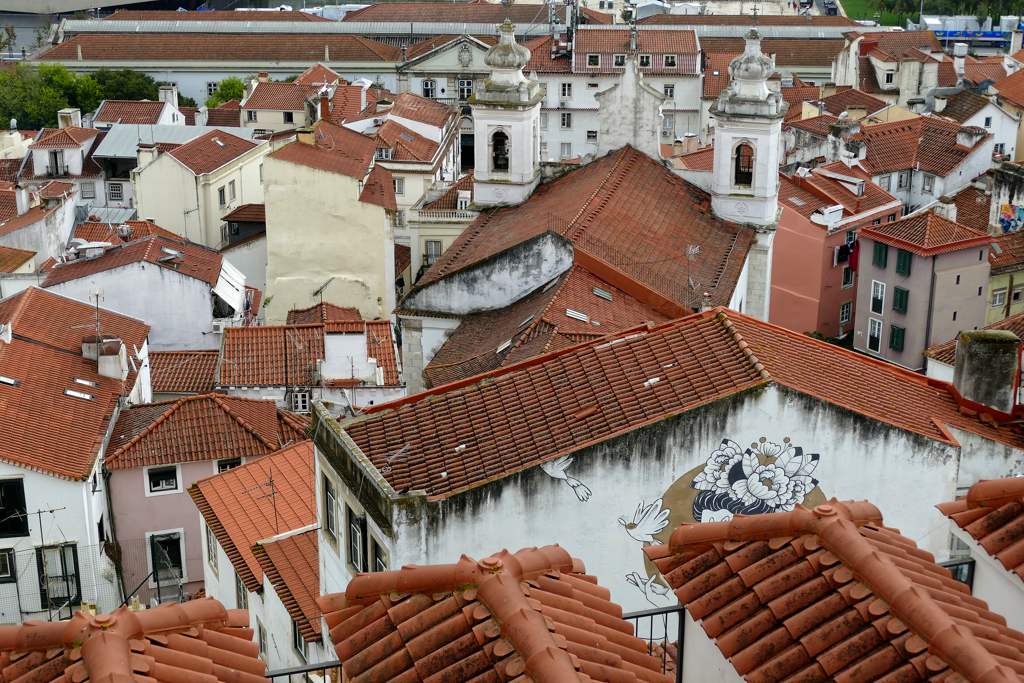
The square is named after the Igreja de Santa Luzia e de São Brás and was built during the reign of Dom Afonso Henriques. However, the current building dates back to the 18th century, having been renovated after the 1755 earthquake.

On the side walls, it has two tile panels representing scenes from the capture of Lisbon from the Moors by the Crusaders in 1147.

There are various options if you want to get to the Miradouro de Santa Luzia from the lower town instead of from the Castel. First of all, you can complete your daily exercise program by climbing the street or even the seemingly endless stairs. As soon as you get to the top, you realize there is an elevator, namely the Elevador de Santa Luzia. For 3 €uros round-trip, it is a cheap and probably the fastest option to get up here. Although trams #12 and the legendary #28 also get here, starting at the Praça Martim Moniz, they are often annoyingly packed and tend to get stuck in traffic. Alternatively, you can take bus #737, which leaves from Praça da Figueira and stops just before the viewpoint.
Miradouro das Portas do Sol
Just a few steps from Miradouro Santa Luzia is another viewpoint. Although the Miradouro das Portas do Sol is a tourist hotspot, it is one of my favorite places in the city. Even the crowds can’t diminish its beauty and charm.
The Portal to the Sun – the English translation of the name – fully lives up to its name.

A larger-than-life statue of Saint Vincent greets you in the square. This patron saint of Lisbon watches over the Church of Santiago and the Palácio Azurara. The viewpoint is on the south side of the castle hill and offers a wide view over the red roofs of the city all the way down to the river. To your left, you will spot the iconic Igreja e Mosteiro de São Vicente de Fora on yet another hill.

If the sky is clear, you can even see as far as the Serra da Arrábida from this viewpoint!
Igreja e Mosteiro de São Vicente de Fora
If you stand on the Miradouro das Portas do Sol, the Igreja e Mosteiro de São Vicente de Fora looks incredibly far away. But that’s only because both spots are on hills. In reality, it’s just a ten-minute walk or three tram stops.
King Alfonso I had the monastery of São Vicente de Fora built in 1147. It was built in the Romanesque style and donated to the Augustinians.

At the time of King John III. and especially from 1590, the monastery was expanded and rebuilt in the Manueline style. The monastery church was also redesigned between 1582 and 1629. During the severe earthquake in Lisbon in 1755, both buildings suffered comparatively little damage. Nevertheless, the dome of the church collapsed.
Of particular importance is the decoration of the monastery with Azulejos. It also houses one of the most important collections of Portuguese paintings from the 17th century. The Panteão da Casa de Bragança in the monastery is the most important burial site of the Portuguese royal family from the House of Braganza.
The complex is open every day from 10 a.m. to 6 p.m. However, church hours may vary on holidays or special occasions.
The general entrance fee of 8 €uros includes access to various areas of the monastery, including the beautiful cloister with the famous Azulejo tiles, the royal pantheon, and the roof terrace from where you’ll have breathtaking views over Lisbon.
Graça
The Graça district in Lisbon is a hidden gem. It has largely retained its charming authenticity, making the neighborhood my absolute favorite district in Lisbon.
Graça is located on one of Lisbon’s highest hills and therefore offers breathtaking panoramic views of much of the city. Particular mention should be made here of the Miradouro da Senhora do Monte and Miradouro da Graça, where the sunsets cast a golden glow over the cityscape and create an almost magical atmosphere.

A walk through the narrow, cobbled streets of Graça sometimes feels like a journey back in time. You’ll come across traditional pastel-colored houses and small, family-run cafes. But despite its peaceful, village-like atmosphere, Graça also boasts lively markets and powerful street art.

As soon as you enter the district from Sapadores Square via Rua Natália Correia, named after the famous Portuguese poet and social activist, you can feel the exceptional flair. Or where else do whole groups of old men play traditional card games below an expressive mural by Shepard Fairey?
By the way, it’s not just the street name that honors Natália de Oliveira Correia. The poet is also immortalized in a work of art at the intersection where Rua Natália Correia turns into Rua da Graça. And she is far from being the only one.
Passeio Literário da Graça
In 2022, in addition to Natália Correia, the writer and women’s rights activist Angelina Vidal, the poet Sophia de Mello Breyner Andresen, as well as Florbela Espanca, known for her passionate and feminist poetry, were honored through the urban art project Passeio Literário da Graça.
In addition to the classic murals, particular attention should be paid to the tile works by Jorge Romão.
The mosaics by this artist, known as Arte Jota, are an impressive trilogy. O Mundo de Sophia, hence, Sophia’s World, in the Calçada do Monte, represents the poetic universe of Sophia de Mello Breyner.
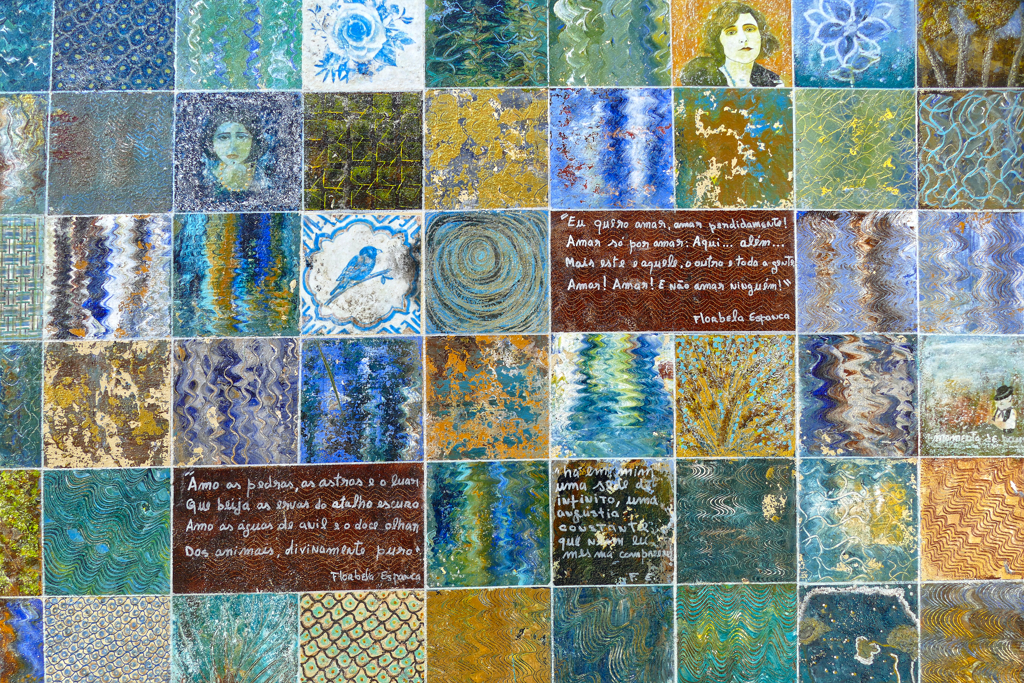
There is also the work Natália – a Indomável, which translates to Natália – the Indomitable and is dedicated to Natália Correia, obviously. Finally, there is O Clamor da Planicie, i.e., the Clamour of the Plain, dedicated to Florbela Espanca and the Alentejo.

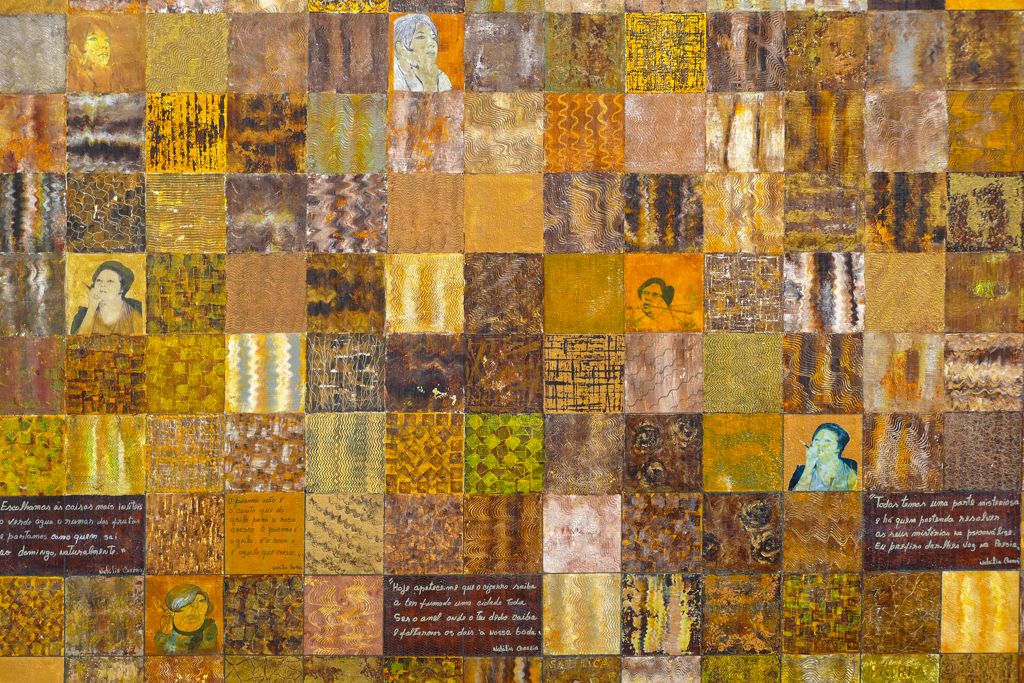
Yet, the Passeio Literário is not the only local project celebrating women. On the occasion of International Women’s Day 2020, the municipality of São Vicente, together with the intercultural collective YESYOUCAN.SPRAY, invited 17 artists to decorate the wall on Rua Josefa de Óbidos.

This art campaign was primarily intended to draw attention to domestic violence against women during the COVID-19 lockdown. Another intention was to underline the need for an eco-revolution from a female perspective.

There’s More
In addition to these special art projects, however, there are a large number of excellent murals in Graça, some of which have been created by internationally famous street artists.

It is beyond the scope of this post to introduce them all. I would therefore like to refer you to my post Best Street Art in LISBON – Part I: Graça And Beyond. However, make sure to check out also the other posts on Lisbon’s urban art Best Street Art in LISBON – Part II: Marvila and Best Street Art in LISBON – Part III: Moscavide!
Miradouro da Senhora do Monte
Two of Arte Jota’s murals can be found along the Calçada do Monte, one of Lisbon’s steepest streets. It leads in a sharp curve to the Miradouro da Senhora do Monte. Although I would deny that it is still a true insider tip, it is actually much quieter than the Mirdouro da Graça, which is just a stone’s throw away.

The hermitage of Nossa Senhora do Monte was founded here in 1147, and it was also from where the first Portuguese king began the reconquest of the city.
Although the historically significant Miradouro da Senhora do Monte is deemed a bit worn, the view over Lisbon is timelessly beautiful, and you can enjoy it as if you were sitting in a luxurious box seat.
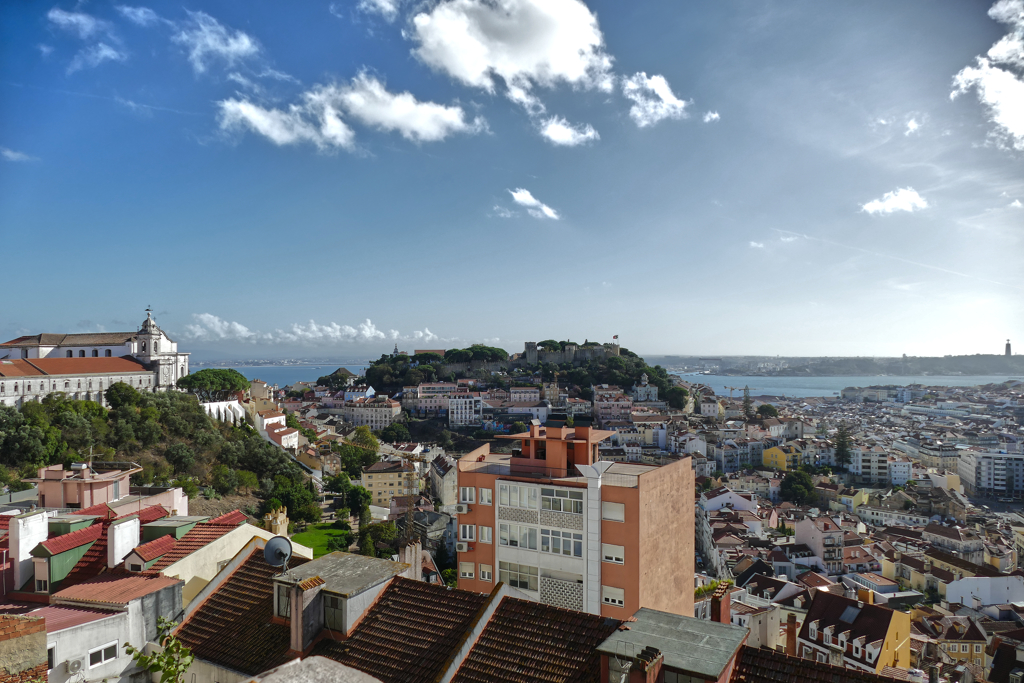
You have an unobstructed view of the Igreja da Graça, the Mouraria district, and the Castelo de São Jorge. If the weather is good, you can even discover the Convento do Carmo on the other side of the city.
Igreja And Mirdouro da Graça
Lisbon isn’t just home to an impressive array of geographic viewpoints. In addition, many buildings offer a front-row seat when it comes to spectacular views of the city.
An Augustinian monastery was founded at today’s Miradouro da Graça as early as the 13th century. The commissioners had understandably chosen a location with a particularly beautiful view.
Unfortunately, the monastery church was damaged by the earthquake in 1755. However, it was later extensively renovated. The interior is in the Rococo style and decorated with beautiful Azulejos from the 17th and 18th centuries.

Visiting some parts of the church is free. To access the terrace, the upper area, and the exhibition space, you have to pay an entrance fee of 5 €uros. Visiting times are every day from 10 a.m. to 7 p.m.
Especially at sunset, you have a wonderful view of the Castelo de São Jorge and the Baixa district from the Miradouro da Graça, also called the Miradouro Sophia de Mello Breyner Andresen. There are numerous seating options around a small kiosk that sells drinks and snacks, so you can take a relaxing break with a view.

The most convenient way to get to Miradouro da Graça is with the brand new funicular. It runs daily from 9 a.m. to 9 p.m. every 10 minutes at the usual fare for Lisbon’s elevators, which is currently 4.10 €uros per return trip. However, it is also included in the 24-hour ticket.
Baixa
The Baixa, or in English Lower Town, is today the heart of Lisbon. The area extends north of the Praça do Comércio, roughly between the Cais do Sodré train station and the Alfama district.
The district is an elegant neighborhood whose construction was commissioned immediately after the devastating earthquake of 1755. The effects of this earthquake were even felt as far as North Africa and Finland. The royal palace and a large part of Lisbon’s lower city were also destroyed by the subsequent tsunami and a huge fire. Obviously, the quake claimed a high number of victims.
Sebastião José de Carvalho e Melo, who was the country’s prime minister from 1750 to 1777 and became known by his noble title Marquês de Pombal, was commissioned with the reconstruction of the city. Instead of following the geographical conditions, the Marquês designed a strictly geometric road network. Even back then, attention was paid to earthquake-proof construction.
Fun Fact
To test the resilience of the structures, military troops had to march stomping around architectural models to simulate an earthquake.
Praça Dom Pedro IV
The Rossio, officially Praça de Dom Pedro IV, is one of the three most important squares in Lisbon. Since the Middle Ages, it has been the scene of numerous celebrations and referendums.
The Rossio became particularly important from the 13th and 14th centuries onwards when Lisbon was expanded further and further towards the River Tagus.

As part of Marquês de Pombal’s reconstruction program of the city after the great earthquake of 1755, in which almost all the buildings on the Rossio had been destroyed, the architects Eugénios dos Santos and Carlos Mardel reconstructed it in the style of Pombalinism. As part of the checkerboard layout of the rebuilt city center, the Rossio received a direct connection to the central Praça do Comércio on the banks of the Tagus via Rua Augusta and Rua Áurea.
In the 19th century, the Rossio received a typical Portuguese floor mosaic. It is made up of gray and white paving stones laid in waves. In the middle are two French fountains decorated with bronze sculptures. In 1874, the new statue of the Portuguese King Pedro IV was erected in the square.

The Rossio underwent a decisive addition at the end of the 19th century with the neo-Manueline train station designed by José Luís Monteiro. It was built for the route to Sintra, where, among other things, the royal summer palace, Palácio Nacional da Pena, was located. Millions of tourists thank the builder for this hub to this day.
Fun Fact
According to legend, the statue in the Rossio Square is not Dom Pedro IV at all. Rather, it is said to be the portrait of Emperor Maximilian of Mexico. The Emperor was assassinated shortly after the statue was completed. The sculpture was therefore no longer needed and was sold to Lisbon for a fraction of the price. Since Emperor Maximilian and Dom Pedro IV looked very much alike, they did get away with it.
Rua Augusta
At around 550 meters, Rua Augusta connects the Praça de Dom Pedro IV with Lisbon’s most important square, the Praça do Comércio. Since the street was converted into a pedestrian zone in 1984, you could stroll here in a relaxed manner if it weren’t for the countless touts who try to lure tourists to their restaurants. The fact that they only cater to tourists should be a warning not to eat there.

The architecture of the boulevard largely dates from the reconstruction period. One of the most noteworthy features is the so-called Calçada Portuguesa, in which white limestone and black basalt are combined into a beautifully patterned sidewalk.
One of the top attractions is undoubtedly the Arco do Triunfo. It marks the central axis of the Baixa Pombalina. Construction took place as part of the re-planning after the earthquake, obviously.

Interestingly, Queen Maria I. dismissed the good Marquês de Pombal after she acceded to the throne in 1775. She had the triumphal arch, started according to his design, torn down in 1777.
It was not until 1875 that a triumphal arch designed under the direction of the architect Veríssimo José da Costa was completed. Amazing statues by sculptors Célestin Anatole Calmels and António Vítor de Figueiredo Bastos embellish the upper part.
The magnificent triumphal arch cannot only be admired from the outside. For 3.50 €uro, you can take an elevator up and enjoy some of the very best vistas. The observation deck is open between 10 a.m. and 7 p.m.
Praça do Comércio
If you stand on top of the Arco do Triunfo, the Praça do Comércio is right at your feet. It is the largest and most important square in the city. In 1511, the Paço da Ribeira palace was completed here on the orders of the Portuguese King Manuel I. It served as a residence for the Portuguese Kings for over 200 years. Located directly on the Lisbon harbor, it was in the vicinity of shipping companies and administrative buildings from which Portugal ruled over its numerous colonies in Africa, America, and Asia.

After the great earthquake, the Praça do Comércio was reconstructed in a new, rectangular shape. Portuguese architect Eugénio dos Santos designed the buildings around the spacious square four stories high. They are lined with arcades and have two wings that end in two large towers. Although the Paço da Ribeira was not rebuilt, Santos cited its splendor in the design of the new magnificent structures.
Now the square also received its new name, Praça do Comércio, or trading square.
Elevador de Santa Justa
On a side street off Rua Augusta is also one of the city’s most famous tourist attractions, the Elevador de Santa Justa. In fact, there is a public passenger elevator that connects the Baixa with the higher district of Chiado. The extraordinary construction made of cast iron was completed in 1902 according to plans by the engineer Raoul Mesnier de Ponsard. Originally, the cabins were moved by a steam engine. It was not until 1907 that they were replaced by electric motors.

In the Baixa, the lower access to the elevator is on Rua Santa Justa. From there, two wooden cabins decorated with glass panes, mirrors, and brass fittings take a maximum of 24 people at a time, 45 meters up to the upper station in the Chiado district. Here, you leave the station via a 25-meter-long metal walkway. Both from the upper exit area and the observation deck above, you have – how could it be otherwise in Lisbon? – a spectacular view of the city.

If you now ask me whether the hype surrounding the Elevador de Santa Justa is justified, I say no. Especially in high season, you’ll be waiting in line forever. After waiting for a good hour, you are squeezed into the cabin with two dozen other people. Mind you, you can hardly see outside. The journey then takes a few minutes, and that’s it. The ride costs 6 €uros one way. However, the elevator is included in both the Lisboa Card and the normal day tickets for public transport.
Chiado
So if you’re not taking the elevator – how do you get to the Chiado? Well, by walking up the Rua do Carmo, located behind the Elevador.
Since the road is long, the climb isn’t that bad. It’s also lined with cute little shops, so you won’t even notice you’re walking uphill.

Today’s Chiado district was once one of the city’s exits to the surrounding country estates and convents. The name of the 16th-century district is reminiscent of António Ribeiro. Ribeiro was a Franciscan from Évora who made his living as a voice impersonator and ventriloquist. For his mocking poems, he earned the nickname Chiado, which meant clever or cunning.
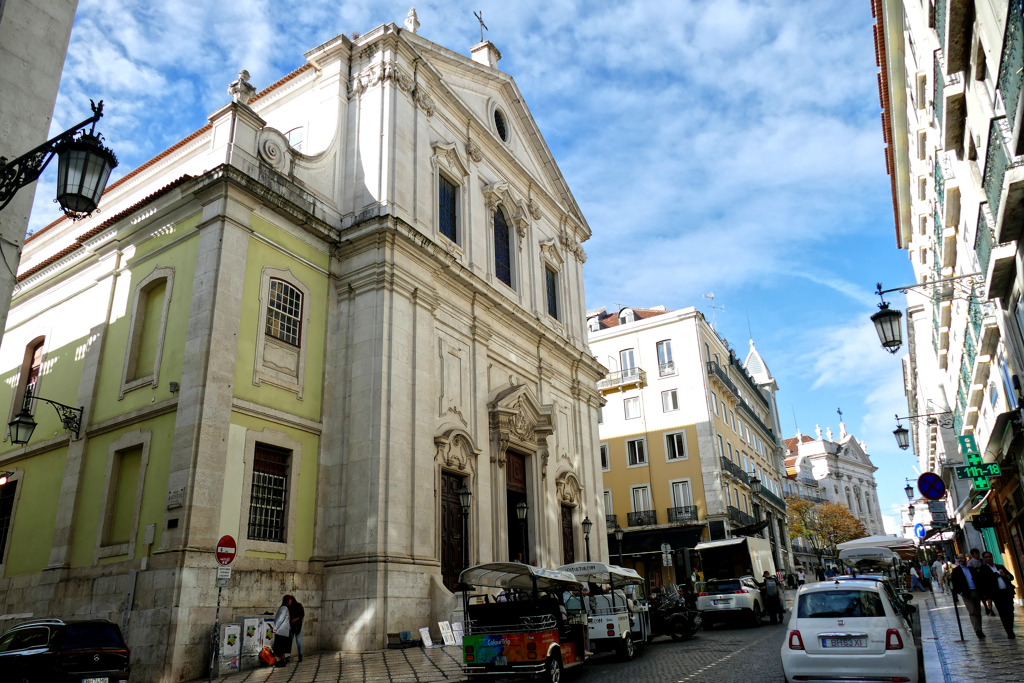
The district was a meeting place for writers and artists until the beginning of the 20th century. The reason was the proximity of the cafés to the surrounding publishers and editorial offices. The Livraria Bertrand is also in Chiado. It is now the oldest existing bookstore in the world.

In 1988, a massive fire broke out in the Grandella warehouses, which quickly spread to large parts of Chiado. Architect Álvaro Siza Vieira from Porto was commissioned to restore the destroyed parts as true to the original as possible. A large number of buildings and even entire sections of the street on Rua Garrett are now listed as historical monuments.
Museu Arqueológico do Carmo
One of the most beautiful and unusual landmarks in Lisbon is the Convento do Carmo. This former monastery of the Carmelite Order was built between 1389 and 1423 on a vow made by Marshal Nuno Álvares Pereira. The building complex also includes the Igreja do Carmo church. It is considered a magnificent example of Lisbon Gothic.

Unfortunately, the earthquake also destroyed this structure. Although Queen Maria I. quickly initiated the restoration, it came to a halt due to the secularization of the monastic orders in 1834. Therefore, only one wing of the monastery could be rebuilt. It is now the headquarters of the Portuguese National Guard.
The Museu Arqueológico do Carmo is housed in the ruins of the monastery church. In summer, concerts are also held in the roofless nave.
The museum is open from Monday to Saturday between 10 a.m. and 7 p.m. and the general entrance fee is 7 €uros.
Guided Tours at the Largo do Chiado
For the longest time, the square was referred to as Largo das duas Igrejas, hence, the square of the two churches. And in fact, the churches Igreja de Nossa Senhora do Loreto and Igreja de Nossa Senhora da Encarnação can be found on the north and south sides of the square.

However, by the decision of the Câmara Municipal of Lisbon, the square was given its current name in 1925.
Today, the Largo do Chiado is the heart of the entire district. In the middle of Praça de Luís de Camões is a statue of the poet after whom the square is named. Additionally, in 1929, a monument to the poet António Ribeiro, after whom the entire district is called, was erected on the west side of the square.

The Praça de Luís de Camões is an excellent starting point for exploring the neighborhood. If you don’t want to walk around alone or don’t want to miss out on the Chiado’s quirks and legends, you can join one of the group tours, such as Chill-Out Lisbon Free Tours. These tours are generally free, but of course, you should give the guide a good tip.
Bica Funicular
Of Lisbon’s funiculars, the Elevador da Bica is the most famous and most photographed. It connects Rua de São Paulo with Largo do Calhariz in the upper town.
The cable car was designed by the Portuguese engineer Raoul Mesnier du Ponsard and put into operation in 1892. At a length of 260 meters, it overcomes a height difference of 45 meters.

Originally powered by water ballast, she was converted to steam in 1896 and finally electrified in 1914. Although it is still used by some locals today, it is basically just a tourist attraction.
Unlike other funiculars in the city, the Bica funicular consists of two tram cars that run in opposite directions from both termini.
The Bica funiculars run every 15 minutes Monday to Saturday from 7 a.m. to 9 p.m., Sundays, the first tram is only at 9 a.m. You have to pay the usual Lisbon elevator fare, which is currently €4.10 per return trip. You can buy tickets from the driver. However, it is also included in the 24-hour ticket.
Museu Nacional de Arte Contemporânea do Chiado
Not far from the Bica Funicular is the National Museum of Contemporary Art, which is worth visiting – and I say this with all due respect as a great art aficionado – mainly for of the venue.
The Museu Nacional de Arte Contemporânea do Chiado, or MNAC in short, was established in 1911. Shortly after the founding of the Republic in Portugal, the government divided the collections of the former National Museum of Fine Arts and Archaeology into two sections. The National Museum of Ancient Art was established in the Palácio das Janelas Verdes, which includes works executed up to 1850.

The works created after 1850 are now housed in the former monastery of São Francisco da Cidade in Chiado. Fittingly, other parts of the old monastery accommodate the Faculty of Fine Arts of the University of Lisbon and the National Academy of Fine Arts.
In the aftermath of the great fire in the Chiado, the French architect Jean-Michel Willmotte had the MNAC completely refurbished in 1994.
Opening hours are Tuesday to Sunday from 10 a.m. to 6 p.m. and the entrance fee is 8 €uros. Make sure not to miss out on the sculpture garden on the roof!
Taking the Tram
Over the past years, riding the #28, a vintage tram from the 1930s that is still part of Lisbon’s public transport network, has become one of the city’s most popular activities. No wonder, because the charming vehicle drives past some important sights.

Inaugurated in 1914, the route of the #28 stretches for 7 kilometers and connects Martim Moniz Square with the Campo de Ourique district. No car or bus can compete with the legendary tram when it comes to squeezing through the narrow streets and around the corners of the older neighborhoods!

To avoid the biggest crowds, it’s best to start your tour as early as possible. To have a better chance of getting a seat, board at the starting point in Martim Moniz.
Depending on traffic, the journey takes around an hour for the entire route.
The single ticket costs 3 €uros and can be purchased from the driver. On the other hand, a day pass that entitles you to unlimited rides on Lisbon’s entire net of public transport, sets you back only 6.60 €uros, hence, it’s easy to do the maths.
A Valid Alternative
Because the #28 passes so many landmarks and iconic places, it’s tempting to get out every time you see something particularly attractive. In theory, this is correct, because if you have a day ticket, you only have to wait for the next tram to continue your journey. Due to the over-tourism that Lisbon in particular suffers from, I advise against using #28 for a sightseeing tour. The vehicles are always full, and there are often long queues at the stops.
For a hop-on, hop-off tour, it’s better to take the official sightseeing tram. It follows the same route, and you can always find a seat. The trip costs 25 euros, but your ticket is valid for 24 hours and includes free access to the Santa Justa elevator and the Bica, Glória, and Lavra funiculars. You can also use an audio guide in several languages. Funnily enough, you can also use your ticket to travel on the regular #28, in case you want to rub shoulders with locals fellow tourists.
You can pre-order your ticket here* to avoid the queue.
Amoreiras
The Amoreiras neighborhood remains under the radar for most visitors. Located in the western part of the city, it is popular for its mix of residential, commercial, and historic elements, making it a unique area.
Amoreiras is known for its upscale residential buildings that feature modern design.
Portuguese architect Tomás Taveira designed the Amoreiras Shopping Center, which opened in 1985. The bold postmodern architecture makes it a landmark. It is worth visiting not only for shopping, but also for its rooftop observation deck, which offers a 360º panoramic view.
Despite its urban feel, Amoreiras also has historical significance due, among other things, to the Mãe d’Água das Amoreiras, a water reservoir that was part of the Águas Livres aqueduct. In the 18th century, it supplied the city with water. Today it is a museum, and from the upper part visitors can – how could it be otherwise in Lisbon? – enjoy a breathtaking vista.
Jardim das Amoreiras
One of the absolute highlights in the Amoreiras district is the Jardim Marcelino Mesquita. Often called Jardim das Amoreiras, it is actually named after the playwright, poet, and writer Marcelino Mesquita.
Marquês de Pombal designed the small park in 1759. Because the garden aimed to boost the Portuguese silk industry, the main center of which was the factory near the square, it is home to around 330 mulberry trees. But there are also other tree species there, including some beautiful specimens of ginkgoes, banana trees, and sycamore trees.

The garden is surrounded by a group of 18th-century houses built as accommodation for the silk workers.
Today the park is the center of the neighborhood: personal trainers steel the muscles of upper-class housewives while children play in a small playground. Old ladies walk their dogs or enjoy a Galão while reading the newspaper at the small tables around the kiosk.
Real Capela de Nossa Senhora de Monserrate
A very special feature at the Jardim das Amoreiras is the Real Capela de Nossa Senhora de Monserrate. Local silk manufacturers commissioned the church concerning French craftsmen who worked at the Royal factory. Interestingly, they squeezed the chapel, built in 1768, between two arches of the Águas Livres aqueduct.
The temple has an octagonal floor plan and a simple dome. The main chapel is covered by a vault with a lowered edge.
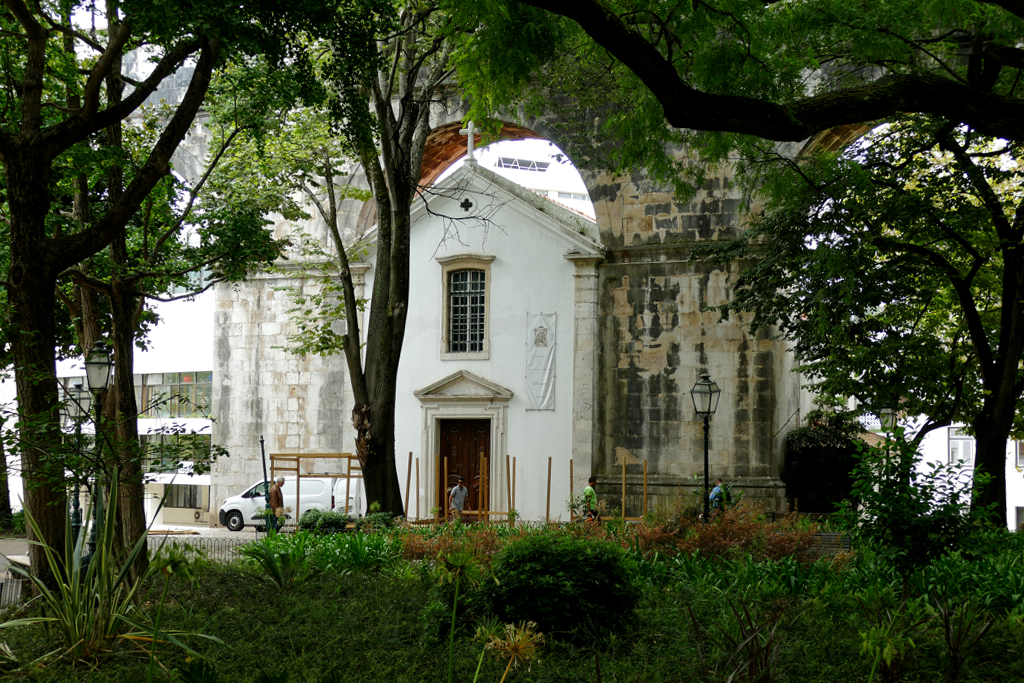
While the façade is very simple, the interior highlights are a wooden altar painted to imitate marble. Traditional tile panels in blue and white produced by the traditional Fábrica do Rato embellish the walls.
To see the inside, you have to be there from Monday to Saturday between 6 p.m. and 7 p.m. or on Sunday from 10 a.m. to 11.15 a.m.
What can I say: curious church, curious opening times.
Mãe d’Água das Amoreiras
Of course, the aqueduct isn’t just there to enclose a chapel. Apparently, it served to supply water to the residents of Lisbon.
The building was completed in 1744 and is considered a masterpiece of baroque engineering.
In 1748, the aqueduct began transporting water to the city of Lisbon. Due to increasing water demands due to the city’s growing population, the system’s capacity has been continually increased.
Amazingly, the infamous Lisbon earthquake did not cause any damage to this masterpiece. Nevertheless, the importance of the aqueduct decreased significantly at the end of the 19th century due to the increasing use of the Alviela Aqueduct. Nevertheless, the aqueduct remained in operation until 1967.

The Mãe d’Água reservoir, which translates to Mother of Water, was the largest and was completed in 1834. Carlos Mardel designed the pool with a capacity of 5,500 cubic meters.
Carlos Mardel was born Martell Károly in Pressburg, now Bratislava, and at that time part of the Kingdom of Hungary. He came to Portugal in 1733 as a sergeant-major in the engineering department of a Portuguese infantry regiment. By 1735, Mardel was the lead architect of the Águas Livres aqueduct. After the earthquake, he was one of the main architects responsible for rebuilding the city
Inside the Mãe d’Água building is a pool with a depth of 7.5 meters. It is now deactivated and can be visited as part of Lisbon’s Museu da Água. At the top of the building is a terrace that offers even more panoramic views of Lisbon.
Opening hours are Tuesday to Sunday from 10 a.m. to 1.30 p.m. and the entrance fee is 4 €uros.
Calouste Gulbenkian Museum
Carlos Mardel was not the only immigrant who brought Lisbon cultural glory. The venues named after Calouste Gulbenkian and the park in which they are located bear witness to this.
The building and gardens were designed as a whole. The main building was completed in 1969 and expanded in 1984 to include the Centro de Arte Moderna or Museum of Modern Art. The project by architects Ruy Jervis Athouguia, Alberto Pessoa, Pedro Cid, Gonçalo Ribeiro Teles, and António Barreto received the Valmor Prize in 1975. It was the first time the award also included the surrounding gardens.

Today it houses the private collection of Calouste Gulbenkian. The permanent exhibition reflects the founder’s diverse art interests and includes a wide selection of art from all eras. It is organized chronologically and geographically.

The exhibition begins with art from antiquity. European book art, as well as European painting and sculpture since the 15th century, is also on display.
Separate rooms are dedicated to the works of Francesco Guardi and René Lalique.
Centro de Arte Moderna Gulbenkian CAM
In addition, the Centro de Arte Moderna Gulbenkian CAM is an important venue for contemporary art. It has one of the largest collections of modern and contemporary Portuguese works of art. On the occasion of its 40th anniversary, the building was renovated and redesigned by Japanese star architect Kengo Kuma.

The museum is open Wednesday to Monday from 10 a.m. to 6 p.m. General admission tickets for both venues cost 14 €uros, and an all-inclusive ticket also including all special exhibitions costs 16 €uros. You can purchase tickets in the museum or in advance online.
Please note that entry is free on Sundays from 2 p.m. But I’d argue the crowds don’t outweigh the small savings.
Calouste Sarkis Gulbenkian
But who exactly was Calouste Gulbenkian?
Gulbenkian was born in Constantinople, hence, today’s Istanbul, in 1869. He was of Armenian origin and received higher education in Marseille, London, and Baku. As a brilliant and successful businessman, he wasn’t active only in Europe, but also in Iraq, South Africa, and Australia. He acquired British citizenship, lived in Paris, and finally moved to Lisbon. Here, he passed in 1955, leaving an incredible fortune both in France and Portugal. This is the reason why long negotiations took place before all the personal art treasures could be sent to Portugal. They are now on display at the Calouste Gulbenkian Museum.
Practical Information
How to Get There
By Plane
Unlike many other European capital cities, Lisbon has only one airport. Therefore, it is served by regular and low-cost airlines alike. The airport is located 7 short kilometers north of Lisbon’s center and conveniently connected with the city by the subway line Vermelha, which translates to red. This metro takes you to the city center in 25 to 35 minutes, depending on your final destination, obviously. A single ticket costs as little as 1.80 €uros.

However, if you are planning on using public transportation the same day, you’d better get a so-called Navegante card already at the airport. I introduce and explain the public transportation system in Lisbon below in the How to Get Around section.
By Train
Travelling by train in Portugal is an eco-friendly choice, reducing your carbon footprint compared to car or plane travel. But train travel is also a scenic way to explore the country, offering comfort, efficiency, and affordable prices. The rail network is very well-developed and reliable.
There are various types of trains, with the so-called Alfa Pendular being the fastest and most comfortable one. It offers free Wi-Fi, air conditioning, and onboard snack service. The so-called Intercidades are slightly slower, however, they are more budget-friendly but still offer comfortable seating and amenities.

Note that discounts are available for advance bookings, seniors, students, and young people under 25. Booking tickets online via the Comboios de Portugal’s website is highly recommended.
There are three major train stations in Lisbon. Firstly, Santa Apolónia, the oldest one yet, to this date, the most important hub for long-distance travel. Secondly, Estação de Caminhos de Ferro do Rossio – short Rossio. From here, trains are leaving, for instance, to Sintra.
Going by train up the Atlantic coast to Estoril, Cascais, or only to Belém, you hop on the train at the train station Cais do Sodré, west of the city center.
By Bus
Traveling by bus in Portugal is a convenient and far more affordable option. Buses connect Lisbon with major cities like Porto and Faro. But they also go to many smaller towns that may not be accessible by train.
Portugal’s main long-distance bus companies Rede Expressos, FlixBus, Renex, and CitiExpress offer reliable and comfortable service. To give you an idea, the bus trip from Lisbon to Porto typically takes around 3 to 4 hours, depending on the service and traffic conditions. A one-way ticket ranges from 10 to 25 €uros, depending on the bus company, how early you book, and whether it’s a peak travel time.
If you travel by long-distance bus Rede Expressos or one of its subsidiaries, you’ll arrive in Lisbon at the terminal Sete Rios, about 4 kilometers north of the historic city center. From here, you can take the blue metro line. Other intercity and international buses depart from the Estação do Oriente. Either way, both stations are well-connected to the Lisbon metro, making them easy to reach from different parts of the city.
How to Get Around
Although Lisbon’s city center is not that big, walking can quickly become tiring. The steep ups and downs of the streets, while picturesque, take their toll. It is therefore advisable to check whether certain corners, even in the high-located old town, cannot be reached by bus or tram. Don’t be surprised: Where normal-sized buses have trouble getting there, minibusses wind their way up and down the city’s hills.

Lisbon has very well-developed public transport. There is a metro, buses, and the legendary
trams. Due to the geographical conditions, public transport in Lisbon also includes elevators and ferries. You can use public transport with your credit card or with the so-called Navegante card. The small paper card costs 50 cents once and can then be topped up with a credit or various tickets.

With so-called zapping, you load a credit of your choice from 3 to 40 €uros onto the Navegante card and can use it for all means of transport.
Which Ticket to Buy
If you travel more than four times a day, a 24-hour ticket for 6.80 €uros is worth it. You can also load several 24-hour tickets onto the card at the same time. They will then work seamlessly one after the other. Also remember that each day ticket includes the Santa Justa elevator, where just a single ride already sets you back 6 €uros, as well as the legendary Bica Funicular. There is also a version including the ferry for 9.80 €uros. Another one for 10.80 €uros includes trains, for example, to Sintra and Cascais.

On the subway and regional trains, you must scan the card at the entrances before boarding and after getting off while in trams and buses, you only have to hold your card up to the reader when you get on, but you don’t have to check out again.
An alternative is the Lisboa Card, which is available for 24, 48, or 72 hours. You can use public transport and also receive free entry to 40 attractions in Lisbon. I’m introducing this pass in the Cash, Cards, and Discount section below.
Where to Sleep
As Lisbon is one of the most touristy cities in Europe, there is a wide range of accommodation to choose from, and many of them are insanely expensive.
It’s often a simple equation: Of the three aspects of a good standard, convenient location, and affordable price, you always have to do without one. If you find a good standard hotel in a convenient location, it will not be at a cheap price. A hotel in a convenient location at an affordable price will not be of good standard. Finally, a good hotel at an affordable price doesn’t have to be in a convenient location. In principle, this also applies to Lisbon.
However, there are some very special accommodation options in the city. While they are definitely a bit more expensive, staying overnight will add a memorable experience to your visit.
One of the best hotels in the city is definitely the Hotel 1908*. Named after the year it opened, it is a stunning mix of historic charm and modern design. Hotel 1908* is housed in a beautifully restored Art Nouveau building and combines architectural elegance with modern comfort. From its stylish rooms to its gourmet restaurant, a stay is not just an overnight stay but a special experience, making it an ideal place for travelers looking for an unforgettable stay in the city. Also, it is very conveniently located in the Intendente district, just two stops from Rossio.
Understandably, not everyone will have the opportunity to splurge. Therefore, on this map, you can choose suitable lodging options in Lisbon according to your individual budget*:
What to Eat
Lisbon, being close to the Atlantic, is known for its seafood. Dishes like Bacalhau à Brás, a blend of shredded salted cod, onions, and eggs, are considered national treasures. Other seafood must-tries definitely include grilled sardines, often served with roasted peppers and potatoes, and Polvo à Lagareiro, octopus roasted with garlic and olive oil.

Don’t worry, carnivores will also get their money’s worth in Portugal. Try Caldo Verde, a hearty soup made from kale, potatoes, and chouriço sausage. Or Cozido à Portuguesa. This is a boiled meat and vegetable stew that includes various cuts of pork, beef, sausages, and cabbage.
Small Snacks
Petiscos are the perfect choice, especially with a drink. Similar to Spanish tapas, these are small snacks that are often ordered to be shared among the entire party.
Bifanas, pork sandwiches spiced with garlic and paprika, are a very popular local fast food.
For a truly immersive experience, visit Mercado da Ribeira, also known as Time Out Market. This food hall brings together top chefs and local eateries, offering a wide range of dishes to be sampled in a vibrant setting.

Don’t forget that Portugal is famous for its wines, and Lisbon offers a fantastic variety. Vinho Verde, a light, slightly effervescent white wine, is perfect for a warm day, while Alentejo reds are rich and full-bodied. While people from Porto swear by Superbock, the most popular beer in Lisbon is Sagres. Also, don’t miss trying Ginjinha, a sour cherry liqueur that is often enjoyed as a quick shot at a bar.
Visiting Organized
I’m an avid solo-travelling woman. Since solo-travel doesn’t equal solitude, I love to join organized tours here and there. Also, to make the most of your trip to Lisbon, especially if you have a limited amount of time, you might want to make some reservations ahead of time. So here are some ideas of what to do and how to visit Lisbon in a safe and easy way*:
Cash, Cards, and Discounts
Until now, 20 European countries replaced their former local currency with the €uro starting in 2002. Obviously, Portugal is one of them. The exchange rate is 1 US$ = 0.84 EUR as of September 2025. However, you can check today’s conversion rate on this page.

Cards are accepted basically everywhere. Except, of course, at the small stands on the streets and at the market.
Most of the time, entrance fees in Lisbon aren’t exactly neck-cutting, but it’s still worth saving a little here and there. And that’s where the Lisboa Card comes into the picture. It is the official sightseeing pass of the city of Lisbon. In addition to free use of the usual means of transport, such as buses, trams, and the metro, trips with the funiculars and elevators, as well as regional trains to Sintra and the coastal towns of Cascais and Estoril are included. This not only saves money, but most importantly, time, as you don’t have to queue every time you need a ticket.
It grants you free access to over 50 museums and monuments, and you can take advantage of the fast tracks at twelve popular places of interest.
You can book the Lisbon Card already before your trip online*. This way, you can exchange the voucher that you’ll get by email at the airport upon arrival and use the metro to the city center for free.
| 24 hours | 48 hours | 72 hours | |
| Lisbon Card | 27 €uros | 44 €uros | 54 €uros |
Language
Did you know that Portuguese is the fifth most spoken language in the world? It is the official language in Brazil, Angola, Cape Verde, Guinea-Bissau, Mozambique, São Tomé and Príncipe, East Timor, and Portugal, obviously. In addition, Portuguese is spoken both in Macau, which was under Portuguese administration until 1999, and in Goa. What I find all the more surprising is how few visitors speak the language – compared to, for example, Spanish.
Speaking of which, if you speak Spanish reasonably well, you’ll be able to at least read Portuguese quite easily, and if someone speaks Portuguese slowly and clearly, you’ll understand a lot, too. It’s a problem with speaking because although Spanish – and Italian, and to a certain extent also French – and Portuguese are similar, they definitely are different languages. You shouldn’t assume that everyone will understand you if you just babble on in Spanish for the sake of simplicity. Furthermore, this is not very much accepted and often perceived as rude. If you want to use Spanish, at least ask at the beginning of the conversation if that would be okay.
I would also like to emphasize how many Portuguese – especially young people, of course – have an excellent command of the English language. Nevertheless, it is a gesture of respect to learn some basic vocabulary, and today this can be done quickly and easily with the help of language apps like Lingohut or Babbel.
Connection and Communication
Since June 2017, no roaming charges have applied within the EU with a European mobile phone contract. This applies to all 27 countries of the European Union as well as Iceland, Liechtenstein, and Norway. It pertains to all contracts.
When roaming is not available, you can connect to the internet in many public places free of charge.
You can get a SIM card if you insist on being online 24/7. For example, cards by LycaMobile start at 10 €uros. However, although the plan lasts for 30 days, keep in mind that it only includes 4 GB of data. Other recommendable providers are MEO, NOS, and Vodafone.
In Portugal, they use plug types C and F. Their voltage is 230 V and the frequency is 50 Hz. Nowadays, as all these chargers have integrated adapters, in general, the voltage and frequency don’t really matter. By the way, you’ll find comprehensive travel info in my post World’s Most Complete Travel Information – an indispensable globetrotter classic.
Lisbon was the last and probably most impressive of many beautiful places I’ve visited in Portugal. To read about the others, go to the main post and take your pick! There you’ll also find valuable general information that will make your trip smoother.
Pinnable Pictures
If you choose to pin this post for later, please use one of these pictures:
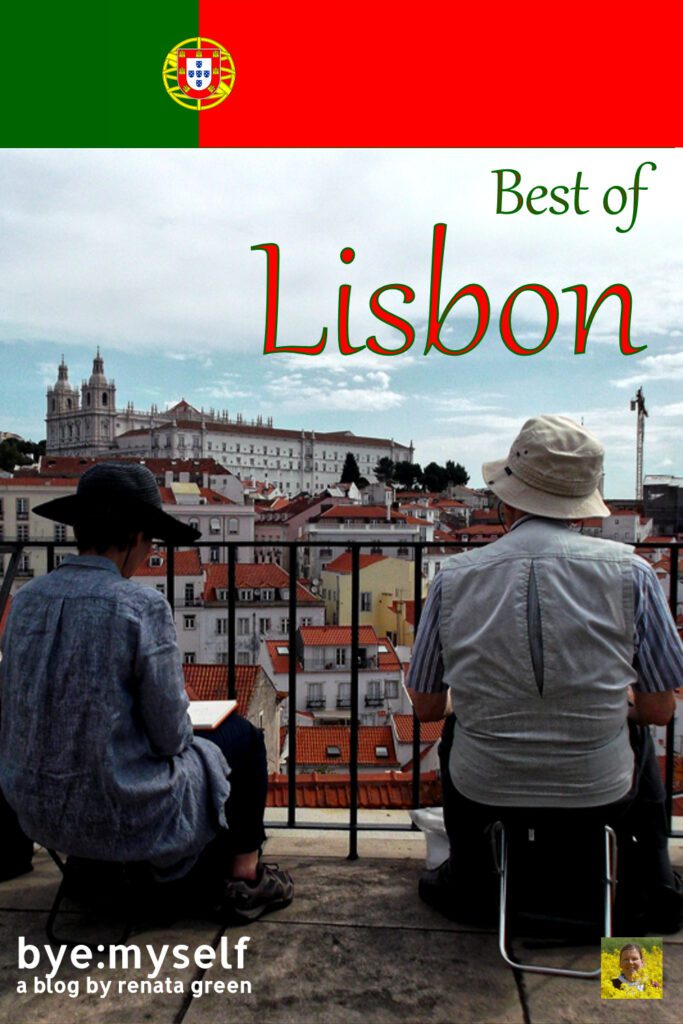





Note: I’m completing, editing, and updating this post regularly – last in September 2025.
Did You Enjoy This Post? Then You Might Also Like These:
Guide to FIGUEIRA da FOZ – a Charmingly Old Fashioned Seaside Resort
Railroad Trip PORTUGAL
Best Street Art in LISBON – Part III: Moscavide
PICO – the Top of the Azores
A Day in Sophisticated ESTORIL and CASCAIS
24 hours in LISBON
Guide to SINTRA – History in Bright Colors
Guide to COIMBRA. On the Beauty of Knowledge
* This is an affiliate link. If you book through this page, not only do you get the best deal. I also get a small commission that helps me run this blog. Thank you so much for supporting me!








